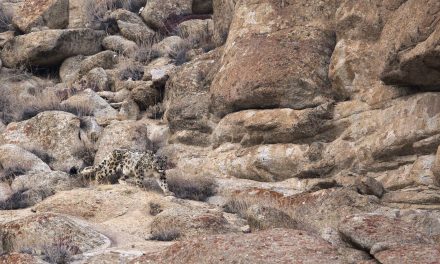
If approved, the pipeline will slice through America’s heartland, putting birds, such as sandhill cranes, at risk. ©John Thomas Andrews
On January 31, 2014, the State Department released its Final Supplemental Environmental Impact Statement of the Keystone XL pipeline in an 11-volume publication. The proposed pipeline segment would carry heavy oil from Canada’s tar sands across Nebraska and five other states to refineries in Texas. The report concluded that, though the tar sands have a somewhat larger carbon footprint than other sources of oil, the pipeline was unlikely to affect the rate at which the oil is extracted; in other words, one way or another, it would find its way to market.
Opponents of the pipeline are worried that this conclusion satisfies one of President Obama’s criteria for approving the project: that it not significantly exacerbate climate change problems. So if environmentalists lose the Keystone XL pipeline battle, what will that mean for other efforts to slow human-caused climate change?
The Keystone XL pipeline battle
The Keystone XL pipeline is a 1,664-mile project that would transport 830,000 barrels of crude oil a day—most of it from Canada’s oil sands—to refineries in Port Arthur, Texas. The pipeline has two segments: the 1,179-mile northern leg between Hardisty, Alberta, and Steele City, Oklahoma, which still requires a presidential permit; and the 485-mile southern leg known as the “Gulf Coast pipeline” between Steele City and Port Arthur, Texas, which was completed in 2013 and is now operating.

The existing and proposed segments of the Keystone XL pipeline run throughout the full length of the U.S. ©Laris Karklis, “The Washington Post.” Updated January 31, 2014.
If approved, the northern leg of the pipeline will slice through America’s agricultural heartland; the Missouri, Niobrara and Platte Rivers; and the Ogallala aquifer, habitat for sage grouse, sandhill cranes, walleye fisheries and much more. Environmentalists worry that public water supplies, croplands and recreational opportunities will all be at risk of dangerous tar sands oil spills, such as the million-gallon Enbridge oil spill in Michigan.
President Obama is now faced with the political difficulty of forbidding a commercial enterprise for “symbolic reasons,” given the State Department’s conclusions. According to that agency’s final numbers, in terms of carbon emissions, stopping the Keystone XL pipeline would be equivalent to stopping the construction of somewhere between half a coal-fired power plant and half a dozen, at a time when China has been building dozens a year. In other words, the pipeline would exacerbate the human-caused climate change problem only incrementally—perhaps significantly, depending on your point of view—but it would not be a game changer for the planet. And, if it’s not built, the oil will get to market anyway, by some other means.
Added to the State Department’s official report, proponents of the pipeline project say that it would promote U.S. energy independence and create jobs, contentions echoed on TransCanada’s own website: the “Keystone XL Pipeline will be the safest and most advanced pipeline operation in North America. It will not only bring essential infrastructure to North American oil producers, but it will also provide jobs, long-term energy independence and an economic boost to Americans.”

The real war we need to fight is against human-caused climate change. The Keystone XL pipeline is just one piece of that battle. ©Kayana Szymczak, flickr
Despite the fact that the State Department report found the pipeline would create only 42,000 temporary construction jobs and 50 permanent jobs, a PEW Research Center poll taken last fall found that 65 percent of Americans—including 51 percent of Democrats—support the pipeline.
It would seem that environmentalists might have picked the wrong battle. If they can’t halt it after five years of pouring resources into trying to mobilize the public against the pipeline, then what project can be stopped?
The larger, climate-change war
Global energy policy expert at the University of California at Davis Amy Myers Jaffe says that by making the Keystone XL pipeline a litmus test, the environmental movement has drawn a line in the sand—dangerous because then you’re stuck with that line. And Susan Casey-Lefkowitz, who directs the Natural Resources Defense Council’s international program, cautions against overemphasizing the pipeline, stating that the real war is human-caused climate change. The Keystone XL pipeline is just one piece of that fight.

The pipeline would “bisect America’s last great swath of grassland.” ©John Thomas Andrews
In response to the January 31 release of the final environmental impact assessment by the U.S. Department of State, Todd Shelton, World Wildlife Fund’s vice president for U.S. government relations, said: “The implications of building the Keystone XL pipeline go beyond climate change. It would accelerate fragmentation of a globally important ecosystem, bisecting America’s last great swath of grassland, home to a diversity of wildlife unique to this region. The project not only would degrade and fragment wildlife habitat, it would also open the door to accelerating oil and gas development and the potentially devastating impacts of pipeline spills, which are all too common.”
The sage grouse, sandhill cranes and walleye would probably agree.
Do you think that fighting the Keystone XL Pipeline is a lost cause? Should environmentalists focus their efforts and resources on larger, global issues?
Here’s to finding your true places and natural habitats,
Candy



































Steve – How much scientific research does it require for you to believe that Climate Change is not among the most important issues threatening species? It is at least equal to the threats of Monsanto and their ilk. Oil Sands is as bad, if not worse, than mountain top removal in the U.S. It not only totally destroys habitat (the number one reason for species loss), it promotes the burning of fossil fuels. Plus the intensive use of energy required in the extraction and processing further adds to atmospheric greenhouse gases beyond that of burning of the oil itself (and far more than any traditional oil extraction methods). Additionally, recent research shows that Oil Sands processing is polluting waters removed from the extraction sites, further exacerbating species risk ( https://www.theglobeandmail.com/news/national/oil-sands-development-polluting-alberta-lakes-study/article7014184/ ).
Over population and basic human self-centeredness and short-sidedness underlie the assualt on global ecosystems. But overcoming our addiction to carbon energy by switching to forms of solar power while cutting back on how much energy we think we need to use is the only answer I see to climate disaster. The Keystone Pipeline may be a line in the sand, but harvesting the tar sands digs the mass grave bigger and faster. So it is very symbolic. There may be other fights that could be even bigger but harder to fight.
I guess you did suggest that the real culprit is our reliance on Carbon, and your post was less an indictment of Keystone per se as a destroyer of habitats for endangered species. On that level I agree with you, but suspect shifting from Carbon will be a long and difficult weaning process,. Yet tropical rain forests and other major ecosystems continue to be under assault by our large and growing global human population. The problem is even bigger than dependence on oil/carbon – it is the total assault on the global ecosystems which support life on this planet.
I am not in total disagreement with the posters here, but wonder how much real fact or evidence is being used to support the statements. I am an environmentalist in Canada and worked for years on Species at risk legislation. But when I see the other major threats to species – for example from Monsanto and its knowing disregard for Monarch butterflies and many other species I wonder if your concerns are all well placed from a priority perspective. Sure, pipeline construction can cause some problems, many of which can be addressed before construction. Yes, atmospheric pollution is a huge problem – but is keystone itself going to contribute that much to that? More so than shipping fuel by tanker from Saudi Arabia or Venezuela?
The policy backsliding on grappling with global warming comes from the top of the U.S. government. Michael Froman is Obama’s top trade negotiator. He has been badgering the EU to lower their fuel standards, which would affect great increases in carbon emissions globally. This signals that Obama is leaning toward approval of Keystone XL. The petroleum coke (oil refinery waste loaded with heavy metals and sulfur) surplus is already getting marketed with zest to the Third World and any other environmentally unscrupulous nation. Fugitive emissions rates from fracking methane already exceed any discount on C emissions based on substituting CH4 for coal in power generation. We must confront the administration on a number of related issues; otherwise, he makes a few modest gestures that get spun by his PR department for major media, and the outcome is business as usual. Support activist organizations and be vocal in your own communities.
I am the executive director of an environmental watchdog group that has focused on preserving the endangered species habitats on San Bruno Mountain just south of San Francisco. I see climate change as an additional, very powerful threat to our work. In addition, its the biggest threat all over the world. If we stay focused only on our narrow issues and ignore this huge one, we will fail in our mission.
Hello; Hydrocarbons as our primary energy source; MUST BE BANNED GLOBALLY ! 🙂
The question is – Do we want our future generations to inherit a living planet and stay alive; or; do we all just want to live now; grab all you can; make a buck; and watch planetary life go out like a candle in a hurricane ? If we; as a species; continue on this egocentric; live for today progress crap direction; our immediate coming generations will be cursing our graves for the wasteland we left for them !!!!!!
I agree with Bill….it is hard to think of an issue that is larger and/or more global. Fighting (hard) against Keystone XL is definitely the right thing to do.
It involves digging through a good chunk of North America & possible species extinction as a means to bring tar-sands oil to the Gulf of Mexico so that it can be sold and shipped abroad. I hardly think this is not a large, global issue.
Go Candice.
Do we really need ,or want, a pipeline that cuts across the entire U.S. carrying one of the worlds dirtest fuels? I would think if we are comitted to finding clean alternative fuels the pipeline would be a slap in the face.